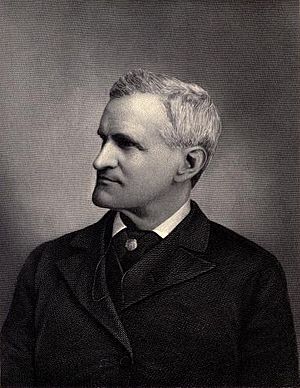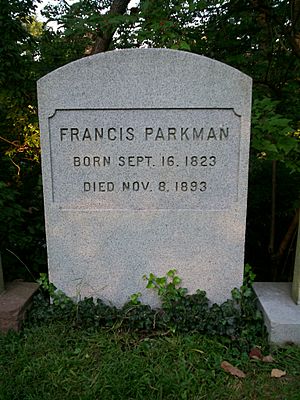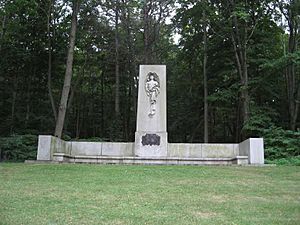Francis Parkman facts for kids
Quick facts for kids
Francis Parkman
|
|
|---|---|
 |
|
| Born | September 16, 1823 Boston, Massachusetts, U.S. |
| Died | November 8, 1893 (aged 70) Boston, Massachusetts, U.S. |
| Resting place | Mount Auburn Cemetery, Massachusetts, U.S. |
| Occupation | Historian, writer |
| Nationality | American |
| Alma mater | Harvard College; class of 1844 |
| Spouse | Catherine Scollay Bigelow |
| Signature | |
Francis Parkman Jr. (born September 16, 1823 – died November 8, 1893) was an important American historian. He is famous for his books like The Oregon Trail: Sketches of Prairie and Rocky-Mountain Life and his big seven-book series, France and England in North America. People still read his books today because they are great history and well-written stories.
Parkman was also very good at horticulture (gardening and growing plants). He even taught about it at Harvard University. He also wrote articles against women being able to vote. He was a leader at the Boston Athenæum library from 1858 until he died.
Contents
Biography
Early Life
Francis Parkman was born in Boston, Massachusetts. His father, Francis Parkman Sr., was a minister. His family was well-known in Boston.
When Francis was a young boy, he was not very healthy. So, his family sent him to live with his grandfather. His grandfather owned a large piece of wild land in Medford. Living there helped Francis become stronger.
He spent four years there and learned to love forests. This love later guided his historical research. He once said his books were "the history of the American forest." He learned how to survive in the wilderness, like a true pioneer. He even learned to ride horses without a saddle. This skill helped him when he lived with the Sioux tribe.
Education and Career
Parkman started at Harvard College when he was 16. During his second year, he planned what would become his life's work. In 1843, at age 20, he traveled to Europe for eight months. This trip was like a "Grand Tour," where young people explored famous places.
Parkman hiked through the Alps and Apennine mountains. He climbed Vesuvius, a famous volcano. He also lived in Rome for a while. There, he met monks who tried to convince him to become Catholic.
After graduating in 1844, his father wanted him to study law. His father hoped this would make him forget about writing history. But it did not work. After law school, Parkman began his great plan.
At first, his family was not happy with his choice. Writing about American wilderness was not seen as a serious job for gentlemen back then. Most historians studied ancient history or the Spanish Empire. But Parkman's books became very popular. By the end of his life, studying early American history became fashionable. Even Theodore Roosevelt dedicated his history of the frontier to Parkman.
In 1846, Parkman went west on a hunting trip. He spent several weeks living with the Sioux tribe. At that time, the Sioux were dealing with problems from contact with Europeans. This experience changed how Parkman wrote about American Indians.
He wrote The Oregon Trail during 1846–1848. He was recovering from an illness in Staten Island, New York and Brattleboro, Vermont. In 1855, he became a member of the American Academy of Arts and Sciences. In 1865, he joined the American Antiquarian Society.
After the Civil War, Parkman helped collect important documents. He worked with others to gather newspapers, books, and pamphlets from the Confederate States of America. Thanks to his efforts, the Boston Athenæum has one of the largest collections of these materials. This helps future historians learn about that time.
Parkman also wrote an essay in 1879 against women's suffrage (the right for women to vote). He believed women were too emotional to be involved in government. This essay was very popular for many years.
Personal Life
Francis Parkman came from a rich Boston family. This meant he had enough money to do his research without worrying about finances. He lived a simple life, and later, he earned money from his books. This allowed him to spend a lot of time on research and travel.
He traveled all over North America. He visited most of the historical places he wrote about. He also made many trips to Europe. There, he looked for original documents to help his research.
Parkman's achievements are even more amazing because he had a serious illness. This illness affected his nerves his whole life. Doctors never fully figured out what it was. Often, he could not walk. For long periods, he was almost blind. He could only see a tiny bit of light. Because of this, others had to read documents to him. He wrote many of his books in the dark or by telling others what to write.
Parkman married Catherine Scollay Bigelow on May 13, 1850. They had three children. One son died when he was young, and soon after, his wife also passed away. Parkman raised his two daughters successfully. He helped them join Boston society and saw them both get married and start their own families.
Parkman died at age 70 in Jamaica Plain. He is buried at Mount Auburn Cemetery in Cambridge. In 1879, Parkman also helped start the St. Botolph Club in Boston. This social club focuses on arts and literature, and he was its first president.
Legacy
Francis Parkman is considered a very important American historian. To honor his talent, the Society for American Historians gives out the Francis Parkman Prize every year. This award is for the best book on American history.
Many famous historians have praised his work. These include Pulitzer Prize winners like C. Vann Woodward and Samuel Eliot Morison. Artists like Thomas Hart Benton and Frederic Remington have drawn pictures for Parkman's books. His books have also been translated into many languages around the world.
In 1865, Parkman built a house at 50 Chestnut Street in Boston. This house is now a National Historic Landmark. The Francis Parkman School in Forest Hills is named after him. So is Parkman Drive and a granite memorial near his last home in Jamaica Plain. On September 16, 1967, the United States Postal Service honored Parkman with a special postage stamp.
Parkman's essay Some of the Reasons Against Woman Suffrage was a very popular book for many years. Groups against women's right to vote continued to use his writings and his famous name long after he died.
Criticism
Some of Parkman's ideas about different groups of people, especially Native Americans, have received criticism. Historian C. Vann Woodward said that Parkman sometimes let his own opinions affect his judgment. Parkman often compared French and English people using ideas about "national character." He also saw a big difference between Indian "savagery" and settler "civilization." This was a common view at the time.
Another historian, W. J. Eccles, criticized Parkman for being unfair to France and the Catholic Church. Eccles also felt Parkman did not always use French historical sources correctly. Eccles wrote that Parkman's book La Salle and the Discovery of the Great West was a great story, but not always accurate history.
Parkman's views on women also brought criticism. He believed women were "impulsive and excitable." He thought they could not be trusted in government. Even though he had his own physical challenges, he still saw women as weak and needing men.
However, many modern historians still praise parts of Parkman's work. They recognize his limitations but also his strengths. Historian Robert S. Allen said that Parkman's history of France and England in North America is still a wonderful mix of history and literature. Literary critic Edmund Wilson also called Parkman's writing "brilliant."
Gallery
-
Francis Parkman School in Forest Hills, circa 1907
Selected Works
- The Oregon Trail: Sketches of Prairie and Rocky-Mountain Life (1847)
- The Conspiracy of Pontiac and the Indian War After the Conquest of Canada (2 vols.) (1851)
- Vassall Morton (1856), a novel
- The Book of Roses (1866). A book about growing roses.
- France and England in North America (1865–1892):
- The Pioneers of France in the New World (1865)
- The Jesuits in North America in the Seventeenth Century (1867)
- La Salle and the Discovery of the Great West (1869; expanded edition, 1879)
- The Old Régime in Canada (1874)
- Count Frontenac and New France under Louis XIV (1877)
- Montcalm and Wolfe (1884)
- A Half Century of Conflict (1892)
- Historic Handbook of the Northern Tour (1885)
- The Journals of Francis Parkman. 2 vols. Edited by Mason Wade. New York: Harper, 1947.
- The Letters of Francis Parkman. 2 vols. Edited by Wilbur R. Jacobs. Norman: U of Oklahoma P, 1960.
- The Battle for North America. A 1-vol. shorter version of France and England in North America, edited by John Tebbel. Doubleday 1948.
See also
 In Spanish: Francis Parkman para niños
In Spanish: Francis Parkman para niños
- The Knickerbocker
- George Parkman — uncle.
- Henri-Raymond Casgrain










